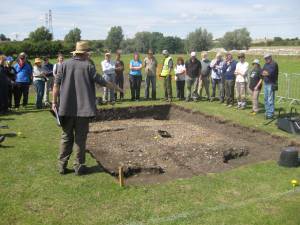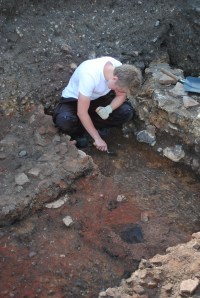And so the circus left town. The Big Top was packed up (under the guidance of Gwen), the caravans and tents trundled away and the elephant was put back in his brightly painted wagon. Actually I made that bit up, but you get the idea.
So after three and a bit weeks, what did we actually find? What do we know about Caistor that we didn’t know before? Well, we haven’t dated any of the finds yet so absolute facts will have to wait, but we can have a little speculation.
In terms of the origins of the town, we still didn’t find any clear evidence of Iron Age occupation. Although there were a handful of possibly Iron Age pot sherds and a beautiful late Iron Age coin, all of these occurred in later contexts. The pot can be seen perhaps as part of the general background noise of Iron Age Norfolk, while the coin could well have been used/saved into the Roman period (as it has bullion value rather than token value). So the Iron Age is somewhere but not where we are digging. Given the now quite considerable number of trenches we’ve now put into the walled town and the south field and the general absence of Iron Age material, we can probably say that on the balance of probability it ain’t there, although we have only reached natural in a handful of places. It may lie to the north. Or somewhere else.
Almost all major Roman towns in Britain have Iron Age or Roman military origins. If we haven’t found the Iron Age, have we got any military evidence? There is some from the site, but interestingly it seems that the church excavations of 2010 produced an animal bone assemblage that is very different from the rest of the Caistor material and reminiscent of those from military sites. It is of course mainly from churned up graveyard contexts so could mean something completely different.
Anyway, we are digging in a Roman town and so we found the Romans. One of the things we wanted to do (in Trench 5) was to get some more dating evidence for the street grid. All the evidence that we have (and also that Atkinson found) suggests a date in the early 2nd century, rather than the post-Boudican date suggested by Donald A. We have now got a (scrappy) collection of pot from under the street which Alice is going to work her magic on and tell us what date the street is. Possibly. Of course it only gives us the date of one bit of the street grid and it’s a big assumption that it was all laid out at the same time. But it’ll be another piece of the big Caistor jig-saw.
The forum was a major focus of excavations this year. It was previously dug by Atkinson but his records left something to be desired. He dug it in two halves (in 1931 and 1933) and never successfully married the two plans of the different bits together. He also never planned any of it in relation to the rest of the town. Most of it was planned in relation to a now vanished fence that he put round the excavation, which isn’t terribly helpful.
The forum sequence that we identified had some things in common with Atkinson’s but differed in some crucial areas. Firstly we found clear evidence of a phase of buildings that was earlier than the structures that Donald A identified as the first masonry forum. These early buildings were at least partly of timber and clay construction and had clearly burnt down in a fairly catastrophic fashion. In both trenches 6 and 7 (aka the long ones) extensive burnt deposits were found including a collapsed roof and a collapsed wall of a timber framed building. Above the collapsed wall was a big deposit of charred grain (which had perhaps been stored in a bag on a shelf). Was this building an early phase of forum? The (annoying) absence of finds suggests that it might have been. The roof collapse in trench 7 contained no material at all, suggesting that the roof was covering an empty (nicely swept) public space. Irritatingly this also means that we’ll have to spend loads of money on carbon dates, which are rubbish for the early Roman period (because the C14 calibration curve is so flat). But never mind.
The early buildings were also decorated with painted wall plaster, which we found in thick deposits of clay in trench 8. The clay was used for the walls of the buildings and the plaster was put on a thick sandy render that was used to seal and face the clay walls. These levels of clay were then cut by the wall of the basilica (which was built using a distinctive clunch type stone, which is non-local so we’ll have to get the nice people at the British Geological Service to identify it for us). All the immediate post-fire phase of the forum was built in this nice stone.
The nice clunch forum was abandoned perhaps at the start of the 3rd century, though Alice hasn’t looked at the pot yet. A thick layer of silt built up (visible in both the long trenches). This was then cut by the foundations of the second masonry forum which dates to per. This is very interesting (honestly), as it shows that the public heart of Caistor apparently lay abandoned for a long time in the middle of the Roman period, which says quite a lot about local attitudes to participating in civic life. When the forum was eventually rebuilt (in the late 3rd or 4th century?) it was on a completely different plan, not reusing any of the earlier walls. This may have been at the same time that the town walls were built, suggesting a project of civic renewal in the late Roman period (rather different to the picture of decline from other late Roman towns in Britain).
We were also looking for the Anglo Saxon period down in trenches 4 and 5, where we were looking for an enclosure that seemed to post-date the street grid on the geophysics. Annoyingly we didn’t find it cutting the street grid although we did find it in trench 4, where it was the latest feature. Trench 4 was in an area which was quite “quiet” on the geophysics, an impression that we wanted to test. In the end the archaeology proved ephemeral but complex, with metalled surfaces and post-built structures, giving some idea of what the town was like away from the main areas of masonry buildings. Post-holes were also cut through the surface of the road in trench 5, while a late pit also truncated the edge of the street. The Anglo Saxons, however, were nowhere to be seen, apart from a single (probably unstratified) sherd of very nice early Saxon pot from trench 6.
So there we are. After 3 seasons of digging, we now have a Caistor that is significantly different to the one we had before. We have a town where occupation and activity ebbs and flows. Probably the initial phase of town life is quite short (perhaps 80 years from c. AD 120 to 200), before there is a major contraction of urban life. The building of the walls signalled a new phase of major occupation, perhaps accompanied by the rebuilding of the forum. This new phase of intensive activity (visible in almost all the trenches we have dug so far) seems to last until the end of the 4th/early 5th century before coming to an end. The Saxon activity is presumably outside the walled town (perhaps on the west side of the river on the Norfolk Archaeological Trust’s new land).
Of course, this may all change once we look properly at the finds but that’s what we think at the moment. Final sword sales were 36. Final cake count was approximately 3,000,000 calories so heartfelt thanks to all our dedicated bakers.
Thanks to all the volunteers (in the trenches, in the tent and on the finds) who worked so hard to get to the end and thanks also to our supervisory team who kept everyone going in a downwards direction. Thanks too, to all those who worked on the BBC family activity days. And, as ever, thanks in particular to Hazel and Dave, who worked so hard to ensure that the dig ran so smoothly.
We are also happy to acknowledge the support of the British Academy which is funding the 2010-12 excavations through a Research Development Award. The success of the project owes much to the continued support of May Gurney and A-Plant who supplied fencing, toilets, tools and containers. Finally, we are particularly grateful to the Norfolk Archaeological Trust, and its director, Peter Wade-Martins, for allowing us to excavate at Caistor and for supporting and encouraging our work.






Leave a comment